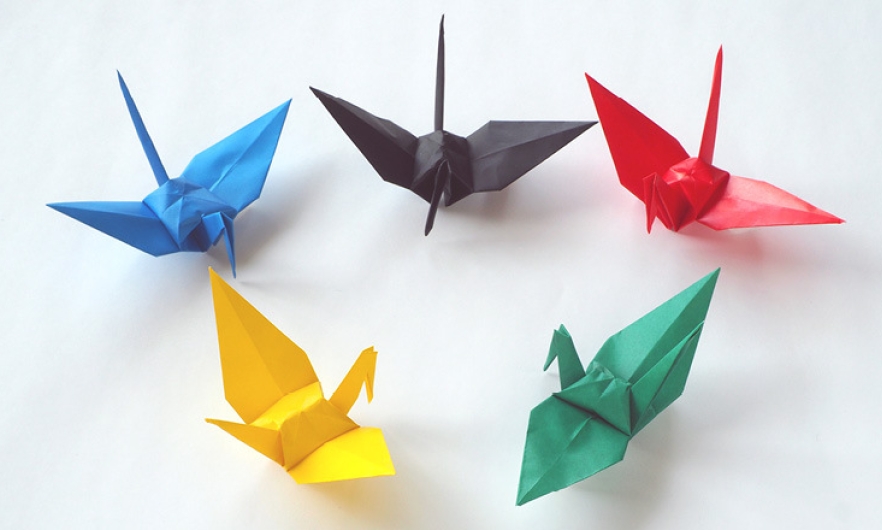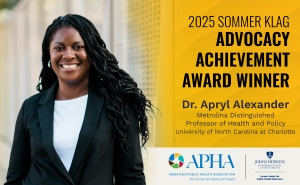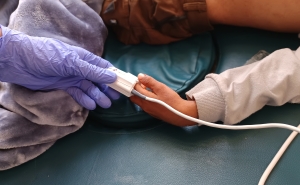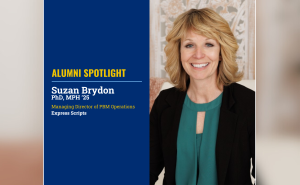Hopeful Steps Forward in the Battle Against COVID-19

Even though we still say “novel coronavirus,” COVID-19 no longer feels new these days.
We asked five department chairs at the Johns Hopkins Bloomberg School of Public Health for updates on where their work stands and what they hope to learn in the coming months. From their diverse perspectives, they each share a snapshot of what’s working, what challenges remain, and what makes them hopeful.
Reshaping Health Services to Meet the Crisis
Colleen Barry, PhD, MPP
Health Policy and Management
When the risks of COVID-19 became clear in mid-March, our faculty quickly advocated for policy and regulatory changes to immediately save lives. For example, we pushed for changes to rules around access to medication for treating opioid use disorder. To allow for social distancing, patients with opioid addiction can now take home a supply of medication previously dispensed only at clinics. We will study whether this shift might be safely extended beyond the pandemic.
To support a more robust and equitable telehealth infrastructure, our faculty who focus on health services research and health information technology are studying ways to create new systems of care and payment models. Other faculty are advising on how to build up the U.S.’s public health infrastructure.
The tools of health policy and management are essential for creating durable legal and regulatory systems to serve us now and in future health crises. In all areas of our response to the COVID-19 pandemic, there is the potential for major long-term gains if we can figure out how to provide health care to people in new ways.
Developing Treatments at Pandemic Speed
Arturo Casadevall, MD, PhD, MS
Molecular Microbiology and Immunology
If you get COVID today, your chances of being very sick are roughly the same as they were three months ago. But on March 1 you did not have remdesivir. You did not have convalescent plasma. So today your chances of survival are better. And if we continue to flatten the curve, those who get infected later will have a lot more options.
I think this is a beautiful story of how, without any governmental organization, physicians and scientists organized to do something that needed to be done—and in a matter of weeks. As of mid-May, about 16,000 patients have been treated with convalescent plasma donated by people who have recovered from COVID-19. As donations increase, we’ll be able to use plasma to boost the immune systems of health care workers and first responders. The pharmaceutical industry is also using plasma donations to create standardized formulas of antibodies. Those will be superior products available in late summer/early fall.
I believe we are going to beat this and—if we can vaccinate large numbers of people—maybe even eliminate it.
Intensifying Collaborations Across Global Networks
David Peters, MD, DrPH ’93, MPH ’89
International Health
From a global perspective, much of the pandemic is still ahead of us. Many innovations are taking place, particularly around using new kinds of data and collaborating across disciplines. However, access to science and technology is not open to all, particularly in poorer countries. We need to address the risks of the most vulnerable populations if we’re all going to benefit.
People are rising to the occasion. This includes not only scientists and frontline workers, but also low-wage daily workers showing everyday heroism. I’m positive about the human species!
Our role as privileged outsiders in a wealthy country like the U.S. is to work with other countries as they figure it out and learn from each other. We at Johns Hopkins have an extensive global network of partners to help with this. Our faculty has for decades built relationships all over the world, and we’re staying in touch, maintaining joint-research protocols. But talking to policymakers is a little more difficult when you are not there.
The trick will be if we can move past the crisis response and take care of the long-term economic and social consequences. Do we learn from this and invest in health equity, or will we return to complacency?
Getting the Epidemiological Data Flowing
David Celentano, ScD ’77, MHS ’75
Epidemiology
As a department, we are deeply into the COVID response. We’re looking at the human genetics of clinical response in patients, including setting up a community cohort in Baltimore that’s enrolling 1,600 families to follow for a year. We really don’t know the basic epidemiology yet because there’s not enough testing. In the next month, we’ll get a handle on what proportion of people are actually getting ill.
Many of us have stopped human interactions, but we’re finding new ways—reaching out by smartphone, doing study visits online. If people can’t come to us, we come to them. We’re learning to be more efficient and cost-effective.
What’s hampering our studies of COVID-19 now is lack of personal protective equipment. A wealthy donor sent 100,000 non-medical masks to researchers at Johns Hopkins that we can use in labs and interviews, and our Doctor of Public Health cohort in Beijing donated 1,200 gowns.
We band together and do what we do. After all, a public health pandemic—the 1918 flu—shaped our School’s mission from the beginning!
Mining Data to Personalize Treatment
Karen Bandeen-Roche, PhD, MS
Biostatistics
We’re working in three areas: population modeling, studying the characteristics of patients in the Johns Hopkins Health System to forecast their outcomes, and putting together clinical data from hundreds of small studies around the country into a common platform so they can be looked at all together.
We are learning so much not only from broad points of view—who are the people who will fare badly—but also from a more detailed point of view—what do their vital sign trajectories look like, what do their lab panel slides show. This gives me a lot of hope that we will be able to personalize the treatment of COVID, including if there’s a second wave.
In each of these areas, the urgency has been a real lever for cooperation. Researchers are freely and quickly making connections with people they’ve never collaborated with before just to answer these questions that require a crazy amount of teamwork to answer. It’s awesome to see the power of this.
Amy Dusto is a freelance writer based in Chicago. Her work has appeared in Discovery News, Symmetry Magazine, and Johns Hopkins Arts & Sciences Magazine, among other publications.





